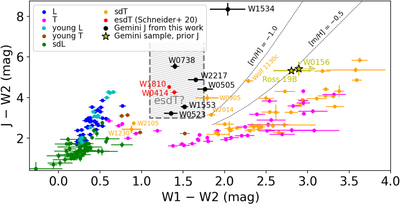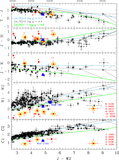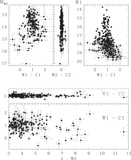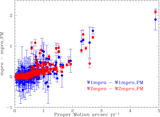Image Details

Caption: Figure 4.
Color–color diagram (adapted from Meisner et al. 2021) highlighting candidate extreme T-type subdwarfs and updated to reflect the J-band results of our Gemini follow-up imaging campaign (black dots). The other samples shown are L dwarfs (blue), young L dwarfs (cyan), L subdwarfs (green), “normal” T dwarfs (magenta), young T dwarfs (brown), T subdwarfs (orange), esdT candidates from Schneider et al. (2020; red; W0414 = WISEA 0414–5854, W1810 = WISEA 1810–1010), and members of our present Gemini sample with J magnitudes from the prior literature (yellow stars). Note the location of WISEA 1534−1043 near the very upper middle. The shaded gray box indicates the fiducial esdT candidate color–color selection proposed in Meisner et al. (2021). Dotted black lines show our model tracks for [m/H] = 0 and [m/H] = −0.5 (labeled in black text near the upper right end of each track). Both of these model tracks have log(g) = 5, log(K zz ) = 7, and γ = 1.25 (Tremblin et al. 2015). CWISE 0738−6643 (labeled W0738) stands out as unusually red in J − W2 for its modest W1 − W2 color, even among the sample of esdT candidates. CWISEP J050521.29−591311.7 (labeled W0505), CWISEP 0905+7400 (labeled W0905; Meisner et al. 2020a), and WISE J201404.13+042408.5 (labeled W2014; Kirkpatrick et al. 2012) are also individually labeled because they fall just outside of the fiducial esdT color–color selection box. The early T subdwarf candidate labeled W1230 is CWISE J123041.80+380140.9 from Kota et al. (2022).
Copyright and Terms & Conditions
© 2023. The Author(s). Published by the American Astronomical Society.












